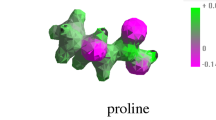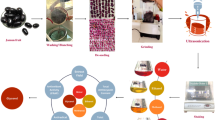Abstract
Grape pomace is a by-product that contains high amounts of phytochemicals such as phenolic acids, flavonoids, and anthocyanins. For the efficient extraction of these compounds, extraction optimization was done in the present study. Glycerol concentration, a cheap, non-toxic and abundant green solvent, and liquid–solid ratio were evaluated as the independent factor of the optimization and total phenolic content, total flavonoid content, free radical scavenging activity, total monomeric anthocyanin content, total proanthocyanidin content and ascorbic acid content was analyzed as responses. The result showed that glycerol concentration significantly affected all responses and increasing the concentration resulted in higher extraction of the phytochemicals. Additionally, liquid–solid ratio affected total phenolic content, total flavonoid content, total proanthocyanidin content and ascorbic acid content of the extracts. Glycerol concentration of 50% (w/v) and liquid–solid ratio of 22.4 was determined to be optimum condition to maximize all responses. The optimum conditions were experimentally validated. Overall, the study showed that homogenizer assisted extraction using glycerol as a green solvent is a good method for extraction of phytochemicals from food processing by-products.

Similar content being viewed by others
References
A. Apostolakis, S. Grigorakis, D.P. Makris, Optimisation and comparative kinetics study of polyphenol extraction from olive leaves (Olea europaea) using heated water/glycerol mixtures. Sep. Purif. Technol. 128, 89–95 (2014). https://doi.org/10.1016/j.seppur.2014.03.010
G. Ruberto, A. Renda, C. Daquino, V. Amico, C. Spatafora, C. Tringali, N.D. Tommasi, Polyphenol constituents and antioxidant activity of grape pomace extracts from five Sicilian red grape cultivars. Food Chem. 100(1), 203–210 (2007). https://doi.org/10.1016/j.foodchem.2005.09.041
Y. Lu, L. Yeap Foo, The polyphenol constituents of grape pomace. Food Chem. 65(1), 1–8 (1999). https://doi.org/10.1016/S0308-8146(98)00245-3
J.M. Yu, M. Ahmedna, Functional components of grape pomace: their composition, biological properties and potential applications. Int. J. Food Sci. Technol. 48(2), 221–237 (2013). https://doi.org/10.1111/j.1365-2621.2012.03197.x
B. Karakashov, S. Grigorakis, S. Loupassaki, D.P. Makris, Optimisation of polyphenol extraction from Hypericum perforatum (St. John's Wort) using aqueous glycerol and response surface methodology. J. Appl. Res. Med. Aromat. Plants 2(1), 1–8 (2015). https://doi.org/10.1016/j.jarmap.2014.11.002
P. Sigala, S. Grigorakis, D.P. Makris, Kinetics of ultrasound-assisted polyphenol extraction from spent filter coffee using aqueous glycerol. Chem. Eng. Commun. 203(3), 407–413 (2016). https://doi.org/10.1080/00986445.2015.1004667
K. Philippi, N. Tsamandouras, S. Grigorakis, D.P. Makris, Ultrasound-assisted green extraction of eggplant peel (Solanum melongena) polyphenols using aqueous mixtures of glycerol and ethanol: optimisation and kinetics. Environ. Process. 3(2), 369–386 (2016). https://doi.org/10.1007/s40710-016-0140-8
D.P. Makris, V. Passalidi, S. Kallithraka, I. Mourtzinos, Optimization of polyphenol extraction from red grape pomace using aqueous glycerol/tartaric acid mixtures and response surface methodology. Prep. Biochem. Biotechnol. 46(2), 176–182 (2016). https://doi.org/10.1080/10826068.2015.1015562
A. Michail, P. Sigala, S. Grigorakis, D.P. Makris, Kinetics of ultrasound-assisted polyphenol extraction from spent filter coffee using aqueous glycerol. Chem. Eng. Commun. 203(3), 407–413 (2016). https://doi.org/10.1080/00986445.2015.1004667
M. Bilgin, S. Şahin, Effects of geographical origin and extraction methods on total phenolic yield of olive tree (Olea europaea) leaves. J. Taiwan Inst. Chem. Eng. 44(1), 8–12 (2013). https://doi.org/10.1016/j.jtice.2012.08.008
B. Baria, N. Upadhyay, A.K. Singh, R.K. Malhotra, Optimization of ‘green’ extraction of carotenoids from mango pulp using split plot design and its characterization. LWT 104, 186–194 (2019). https://doi.org/10.1016/j.lwt.2019.01.044
G.A. Pereira, G. Molina, H.S. Arruda, G.M. Pastore, Optimizing the homogenizer-assisted extraction (HAE) of total phenolic compounds from banana peel. J. Food Process Eng. 40(3), e12438 (2017). https://doi.org/10.1111/jfpe.12438
M. Bilgin, S. Sahin, M.U. Dramur, L.M. Sevgili, Obtaining scarlet sage (Salvia coccinea) extract through homogenizer- and ultrasound-assisted extraction methods. Chem. Eng. Commun. 200(9), 1197–1209 (2013). https://doi.org/10.1080/00986445.2012.742434
G. Derringer, R. Suich, Simultaneous optimization of several response variables. J. Qual. Technol. 12(4), 214–219 (1980)
C. Dincer, A. Topuz, H. Sahin-Nadeem, K.S. Ozdemir, I.B. Cam, I. Tontul, R.S. Gokturk, S.T. Ay, A comparative study on phenolic composition, antioxidant activity and essential oil content of wild and cultivated sage (Salvia fruticosa Miller) as influenced by storage. Ind. Crops Prod. 39, 170–176 (2012). https://doi.org/10.1016/j.indcrop.2012.02.032
C.-H. Chang, H.-Y. Lin, C.-Y. Chang, Y.-C. Liu, Comparisons on the antioxidant properties of fresh, freeze-dried and hot-air-dried tomatoes. J. Food Eng. 77(3), 478–485 (2006). https://doi.org/10.1016/j.jfoodeng.2005.06.061
I. Tontul, A. Topuz, Effects of different drying methods on the physicochemical properties of pomegranate leather (pestil). LWT Journal 80, 294–303 (2017). https://doi.org/10.1016/j.lwt.2017.02.035
T. Barros, L. Galego, P. Pires-Cabral, Monstera deliciosa fruit: physicochemical characterization and potential for distillate production. J. Food Meas. Charact. 12(4), 2874–2882 (2018). https://doi.org/10.1007/s11694-018-9902-5
S. Blidi, M. Bikaki, S. Grigorakis, S. Loupassaki, D.P. Makris, A comparative evaluation of bio-solvents for the efficient extraction of polyphenolic phytochemicals: apple waste peels as a case study. Waste Biomass Valoriz. 6(6), 1125–1133 (2015)
Q. Xu, Y. Shen, H. Wang, N. Zhang, S. Xu, L. Zhang, Application of response surface methodology to optimise extraction of flavonoids from Fructus sophorae. Food Chem. 138(4), 2122–2129 (2013). https://doi.org/10.1016/j.foodchem.2012.11.099
S.I. Mussatto, L.F. Ballesteros, S. Martins, J.A. Teixeira, Extraction of antioxidant phenolic compounds from spent coffee grounds. Sep. Purif. Technol. 83, 173–179 (2011). https://doi.org/10.1016/j.seppur.2011.09.036
W.H. Wong, W.X. Lee, R.N. Ramanan, L.H. Tee, K.W. Kong, C.M. Galanakis, J. Sun, K.N. Prasad, Two level half factorial design for the extraction of phenolics, flavonoids and antioxidants recovery from palm kernel by-product. Ind. Crops Prod. 63, 238–248 (2015). https://doi.org/10.1016/j.indcrop.2014.09.049
L. Yang, Y.L. Cao, J.G. Jiang, Q.S. Lin, J. Chen, L. Zhu, Response surface optimization of ultrasound-assisted flavonoids extraction from the flower of Citrus aurantium L. var. amara. Engl. J Sep Sci 33(9), 1349–1355 (2010). https://doi.org/10.1002/jssc.200900776
P. **g, M.M. Giusti, Effects of extraction conditions on improving the yield and quality of an anthocyanin-rich purple corn (Zea mays L.) color extract. J. Food Sci. 72(7), C363–368 (2007). https://doi.org/10.1111/j.1750-3841.2007.00441.x
G.-L. Liu, H.-H. Guo, Y.-M. Sun, Optimization of the extraction of anthocyanins from the fruit skin of Rhodomyrtus tomentosa (Ait) Hassk and identification of anthocyanins in the extract using high-performance liquid chromatography-electrospray ionization-mass spectrometry (HPLC-ESI-MS). Int. J. Mol. Sci. 13(5), 6292–6302 (2012)
J.P. Maran, V. Sivakumar, K. Thirugnanasambandham, R. Sridhar, Extraction of natural anthocyanin and colors from pulp of jamun fruit. J. Food Sci. Technol. 52(6), 3617–3626 (2015). https://doi.org/10.1007/s13197-014-1429-0
H.-L. Jiang, J.-L. Yang, Y.-P. Shi, Optimization of ultrasonic cell grinder extraction of anthocyanins from blueberry using response surface methodology. Ultrason. Sonochem. 34, 325–331 (2017). https://doi.org/10.1016/j.ultsonch.2016.06.003
Q.V. Vuong, S. Hirun, P.D. Roach, M.C. Bowyer, P.A. Phillips, C.J. Scarlett, Effect of extraction conditions on total phenolic compounds and antioxidant activities of Carica papaya leaf aqueous extracts. J. Herb. Med. 3(3), 104–111 (2013). https://doi.org/10.1016/j.hermed.2013.04.004
N.-Y. Kim, M.-K. Jang, D.-G. Lee, K.H. Yu, H. Jang, M. Kim, S.G. Kim, B.H. Yoo, S.-H. Lee, Comparison of methods for proanthocyanidin extraction from pine (Pinus densiflora) needles and biological activities of the extracts. Nutr. Res. Pract. 4(1), 16–22 (2010)
D.J. Bhuyan, Q. Van Vuong, A.C. Chalmers, I.A. van Altena, M.C. Bowyer, C.J. Scarlett, Microwave-assisted extraction of Eucalyptus robusta leaf for the optimal yield of total phenolic compounds. Ind. Crops Prod. 69, 290–299 (2015). https://doi.org/10.1016/j.indcrop.2015.02.044
M.Z. Anđelković, A.S. Milenković-Andjelković, B. Radovanović, A. Radovanović, Optimization of ultrasound-assisted extraction of phenols from seeds of grape pomace. Acta Chim. Slov. 61(4), 858–865 (2014)
E. Eroglu, I. Tontul, A. Topuz, Optimization of aqueous extraction and spray drying conditions for efficient processing of hibiscus blended rosehip tea powder. J. Food Process. Pres. 42(6), e13643 (2018). https://doi.org/10.1111/jfpp.13643
B. Widom, Collision theory of chemical reaction rates. J. Adv. Chem. Phys. 5, 353–386 (1962)
Author information
Authors and Affiliations
Corresponding author
Ethics declarations
Conflict of interest
The authors declare that they have no conflict of interest.
Additional information
Publisher's Note
Springer Nature remains neutral with regard to jurisdictional claims in published maps and institutional affiliations.
Rights and permissions
About this article
Cite this article
Eyiz, V., Tontul, I. & Turker, S. Optimization of green extraction of phytochemicals from red grape pomace by homogenizer assisted extraction. Food Measure 14, 39–47 (2020). https://doi.org/10.1007/s11694-019-00265-7
Received:
Accepted:
Published:
Issue Date:
DOI: https://doi.org/10.1007/s11694-019-00265-7




